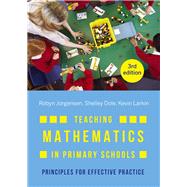The book first examines the philosophy behind mathematics and its impact on curriculum design, the history of learning outcomes, and theories on how students learn mathematics. The key areas of mathematics teaching are then outlined in detail: number, probability and statistics, measurement, geometry, and algebra. In each area, the emphasis is on problem-solving. Finally, practical classroom issues are discussed such as the trend towards developing students' capacity to think mathematically, broad approaches to teaching mathematics, planning for a whole school approach to mathematics, diversity and access, and assessment, reporting and evaluation. A new focus on numeracy and the integration of digital technologies to enhance mathematics education have been incorporated in this edition.
Featuring practical activities that can be implemented in the classroom, together with diagram, graphs, and other visual aids, this book is an invaluable resource for university lecturers as well as pre-service and in-service teachers.









